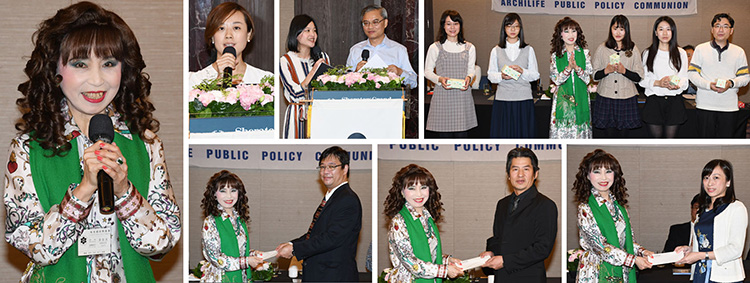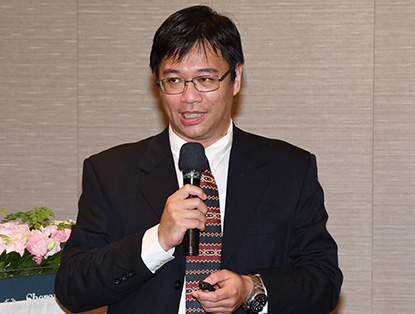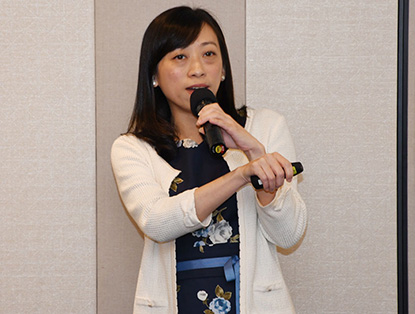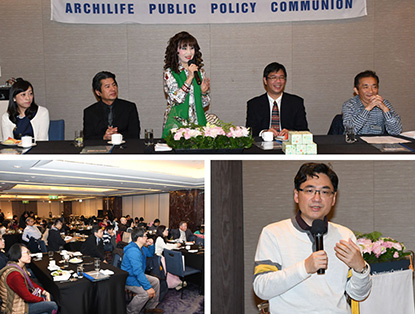Sketch of Public Policy Communion, March 2019Date: 2019-04-17
Section: Activity | 
本會於2019年3月17日假台北喜來登大飯店地下二樓喜廳舉行「祐生國政聯誼會」。在主持人黃晉英秘書長宣布後揭開當日活動序幕,在輕鬆、活潑的節目過後,隨即由主持人帶來重要訊息:「相信大家都還記得林俊興董事長之年度宣告:「預估的情境都已經浮現,黑天鵝排隊準備登場。良機要掌握,危機要躲避。」提醒大家在天災與人禍交互影響下,行事準則應更為保守,並且懂得趨吉避凶。另外,目前假新聞、網路謠言充斥,個人在傳遞訊息前,應謹慎確認真偽,不隨意散佈,使國家社會氛圍較為平和。因此,鼓勵大家多多參與讀書會,累積足夠的知識,才能做出正確的判斷。」
The March Archilife Public Policy Communion of 2019 was held on March 17, 2019. After a series of relaxing and fun activities, Secretary General Huang Chin-ying made the following announcement, "I believe everyone still remembers the annual announcement made by President Lin Chun-shin reminding us that: "The forecasted situation has emerged, the black swans are waiting in line to prepare for the show. The opportunity is to be grasped, the crisis should be avoided." under the influence of natural and man-made disasters, we should take more conservative principles and know how to steer away from bad things. Moreover, now that fake news and internet rumors are everywhere, we should be careful about their authenticity before propagating them and not spread fake information to make this country and society peaceful. Therefore, we encourage all to participate more at our study group so you would have enough knowledge to make a correct judgment."
 緊接著進行專題演講,由國政會委員楊正帆先生主講「台灣細胞治療技術現況」。主講人首先說明全民健保財務狀況,近幾年支出因新藥、新特材及慢性病、癌症醫療費用而有所增加。健保局也以門診減量2%及取消多種藥品健保給付來因應。主講人接著提到美國以間質幹細胞注入軟骨增生了15%的案例,唯台灣尚未有此治療方式。而幹細胞大致分為胚胎幹細胞與體幹細胞兩大類別,主講人也舉出hESC黃斑部病變的治療及日本iPS在各大學進行臨床實驗的案例,表示在國外幹細胞的研究方興未艾,而台灣尚無進展。主講人表示細胞治療是門檻高,認證難的一個領域,極適合成為台灣下一階段發展的火車頭。 緊接著進行專題演講,由國政會委員楊正帆先生主講「台灣細胞治療技術現況」。主講人首先說明全民健保財務狀況,近幾年支出因新藥、新特材及慢性病、癌症醫療費用而有所增加。健保局也以門診減量2%及取消多種藥品健保給付來因應。主講人接著提到美國以間質幹細胞注入軟骨增生了15%的案例,唯台灣尚未有此治療方式。而幹細胞大致分為胚胎幹細胞與體幹細胞兩大類別,主講人也舉出hESC黃斑部病變的治療及日本iPS在各大學進行臨床實驗的案例,表示在國外幹細胞的研究方興未艾,而台灣尚無進展。主講人表示細胞治療是門檻高,認證難的一個領域,極適合成為台灣下一階段發展的火車頭。
Next on the schedule was the keynote speech. First, Mr. Yang Cheng-fan spoke on "The Current Situation of Cell Treatment Technology in Taiwan". The speaker first talked about financial status of national health insurance and mentioned. In recent years, expenditure has increased due to new drugs, new specialties, and chronic diseases and cancer medical expenses, in which the National Health Insurance Administration responded to it by reducing outpatients by 2% and cancelled the benefit of various kinds of medicines. The speaker then mentioned an American case in which mesenchymal stem cell was injected into cartilage and enabled the latter to proliferate by 15%, a treatment that is not available yet in Taiwan. Stem cells can be categorized into embryonic stem cell and somatic stem cell. The lecturer also talked about clinical experiment cases on hESC age-related macular degeneration treatment and Japan iPS at various universities, indicating that while researches on stem cell is thriving oversea, Taiwan has not showed any progress yet. The speaker then mentioned that cell treatment has a high threshold and hard-to-certificate field, which makes it an appropriate topic for Taiwan's development for the next generation.
 接著由國政會委員戴永禔先生主講「共創生計-體驗式教學之農村服務學習」。主講人首先表示目前著手於行政院農業委員會水土保持局的農村改造計畫,以社區營造方式進行,使學生能以服務學習獲取知識與經驗的成長。原住民專班的學習,著重身體的實踐與記憶,為了將有限的資源有效運用,採用不同年級一起上課的教學法,也與部落合作,帶著學生前進部落。主講人也分享豐富的圖示,讓與會者更能瞭解其中過程。主講人亦提及傳統部落生計,其中一項就是重建小米系統,期望能使原住民衰退的農村體制,獲得經濟、社會及生態結構的轉變,也讓每屆學生能將成果複製,促進更理想的部落生活。 接著由國政會委員戴永禔先生主講「共創生計-體驗式教學之農村服務學習」。主講人首先表示目前著手於行政院農業委員會水土保持局的農村改造計畫,以社區營造方式進行,使學生能以服務學習獲取知識與經驗的成長。原住民專班的學習,著重身體的實踐與記憶,為了將有限的資源有效運用,採用不同年級一起上課的教學法,也與部落合作,帶著學生前進部落。主講人也分享豐富的圖示,讓與會者更能瞭解其中過程。主講人亦提及傳統部落生計,其中一項就是重建小米系統,期望能使原住民衰退的農村體制,獲得經濟、社會及生態結構的轉變,也讓每屆學生能將成果複製,促進更理想的部落生活。
Next, Mr. Tai Yung-ti spoke on "Livelihood Co-creation: Experiential Learning of Agricultural Village Service Learning". The speaker first mentioned that the agricultural village reformation project carried out by the Soil and Water Conservation Bureau is implemented with community building method in order for students to obtain knowledge and accumulate experience through service learning. The teaching at aborigine classes stressed the physical practice and memory. In order to effectively utilize limited resources, students from different grades were taught together. They cooperated with tribes and took students there. The presenter also shared a wealth of illustrations to give participants a better understanding of the process. The speaker also mentioned that one of the important tasks in the livelihood of traditional tribes is to rebuild the millet system with the expectation of creating economic, social and ecological transformation to the aborigine's degenerating agricultural village system. It also seeks to duplicate its past progress and promote a more ideal tribal life.
 接著由國政會委員葉娟礽小姐主講「『前瞻‧城鄉‧文化生活圈建設』重建臺灣音樂史計畫─數位化與循環型文化環境建構」。主講人首先表示本次講述行政院前瞻基礎建設計畫其中一環,包括臺灣音樂史的循環型文化環境建構包括典藏與保存、研究與出版及詮釋展演等。而數位化的部分,於2011年建置了臺灣音樂資訊交流平臺、臺灣音樂群像資料庫及傳統民族及樂器資料庫等網站,於2017年建置臺灣音樂館線上虛擬展示館網站,並於今年3月開放音樂文化地圖網站供民眾瀏覽使用。主講人表示,去年共舉辦了10場各地各族群的展演活動,期望透過計畫的執行,保存台灣最美好的聲音。 接著由國政會委員葉娟礽小姐主講「『前瞻‧城鄉‧文化生活圈建設』重建臺灣音樂史計畫─數位化與循環型文化環境建構」。主講人首先表示本次講述行政院前瞻基礎建設計畫其中一環,包括臺灣音樂史的循環型文化環境建構包括典藏與保存、研究與出版及詮釋展演等。而數位化的部分,於2011年建置了臺灣音樂資訊交流平臺、臺灣音樂群像資料庫及傳統民族及樂器資料庫等網站,於2017年建置臺灣音樂館線上虛擬展示館網站,並於今年3月開放音樂文化地圖網站供民眾瀏覽使用。主講人表示,去年共舉辦了10場各地各族群的展演活動,期望透過計畫的執行,保存台灣最美好的聲音。
Next, Ms. Yeh Jiuan-reng spoke on "Forward-looking Urban and Rural Cultural Living Circle Building’Project on Re-constructing the Musical History of Taiwan: Digitalization and Construction of Circular Cultural Environment".The speaker first mentioned that this is a part of the basic design of the Executive Yuan. The circular cultural environment construction of Taiwan's musical history includes archive collection, research, publication and performance. Regarding digitalization, the Taiwan Music Information Exchange Platform Database, the Online Database of Taiwanese Musicians, Traditional and Folk Instrument Database and other websites have been constructed on 2011. The online virtual exhibition hall of Taiwan Music Institute has been constructed on 2017 and its Music Culture Map website has been opened on March 2019. The speaker mentioned that 10 performances on different ethnic groups had taken place at various locations in 2018. She expected that through the implementation of such plan, the beautiful sounds of Taiwan can be preserved.
 演講完畢,黃晉英秘書長代表基金會致贈謝禮予主講人。接著在與會者紛紛利用「餵豬時間」提出個人意見與看法互相交流後,圓滿地結束三月份國政聯誼會。 演講完畢,黃晉英秘書長代表基金會致贈謝禮予主講人。接著在與會者紛紛利用「餵豬時間」提出個人意見與看法互相交流後,圓滿地結束三月份國政聯誼會。
After the speech, Secretary General Huang Chin-ying presented a gift to the speakers on behalf of the foundation. Then, attendees expressed and exchanged their opinions and views during the piggy hour. The March Archilife Public Policy Communion ended smoothly.
|
|